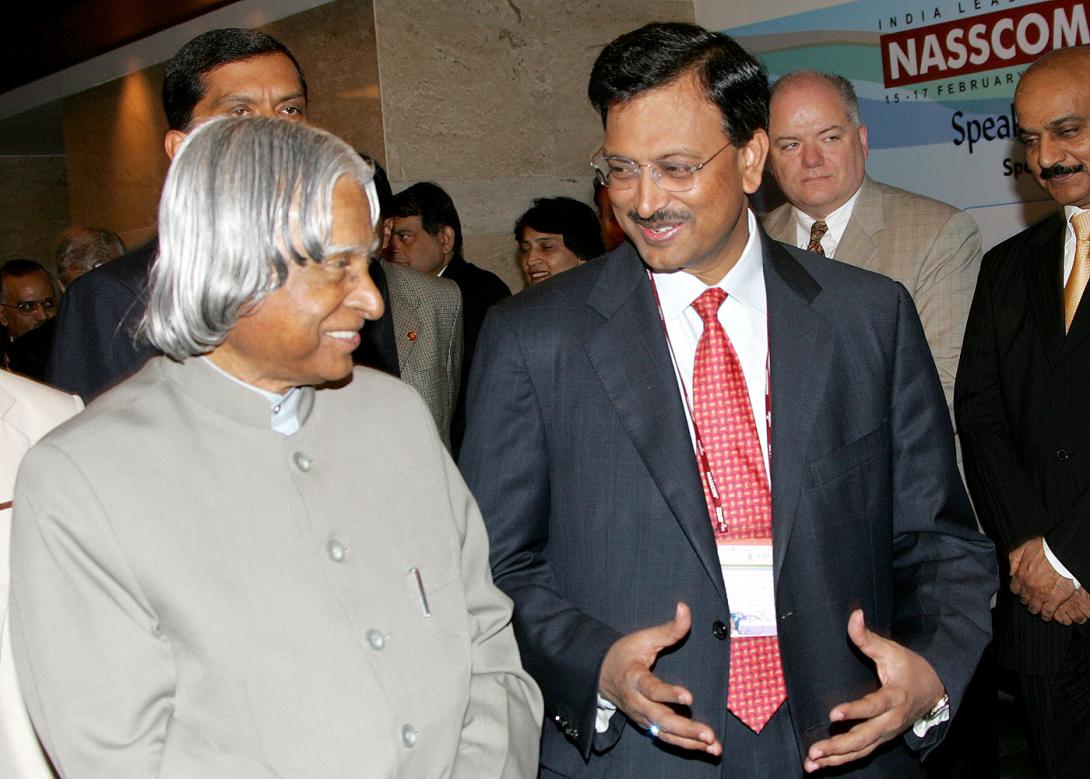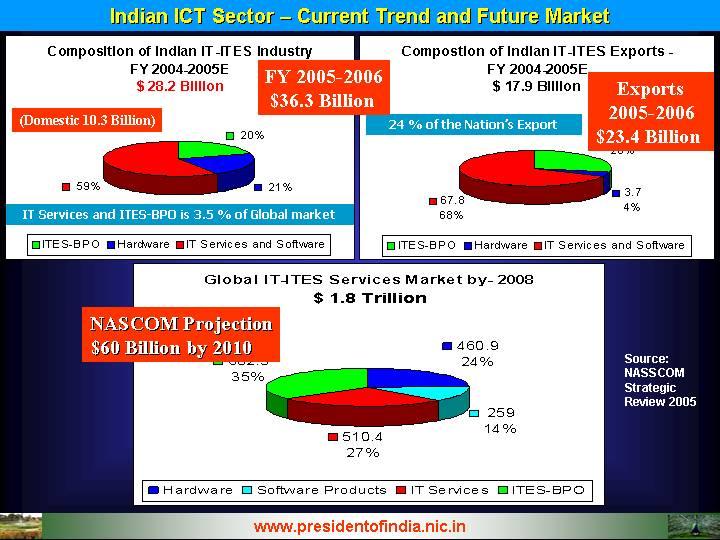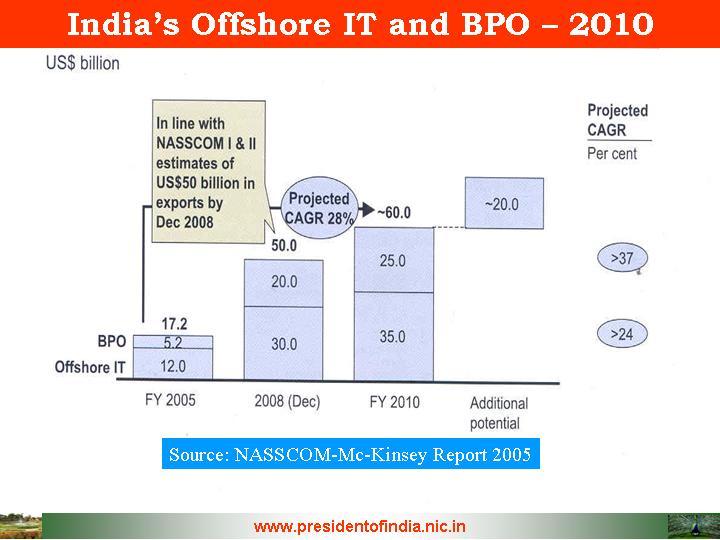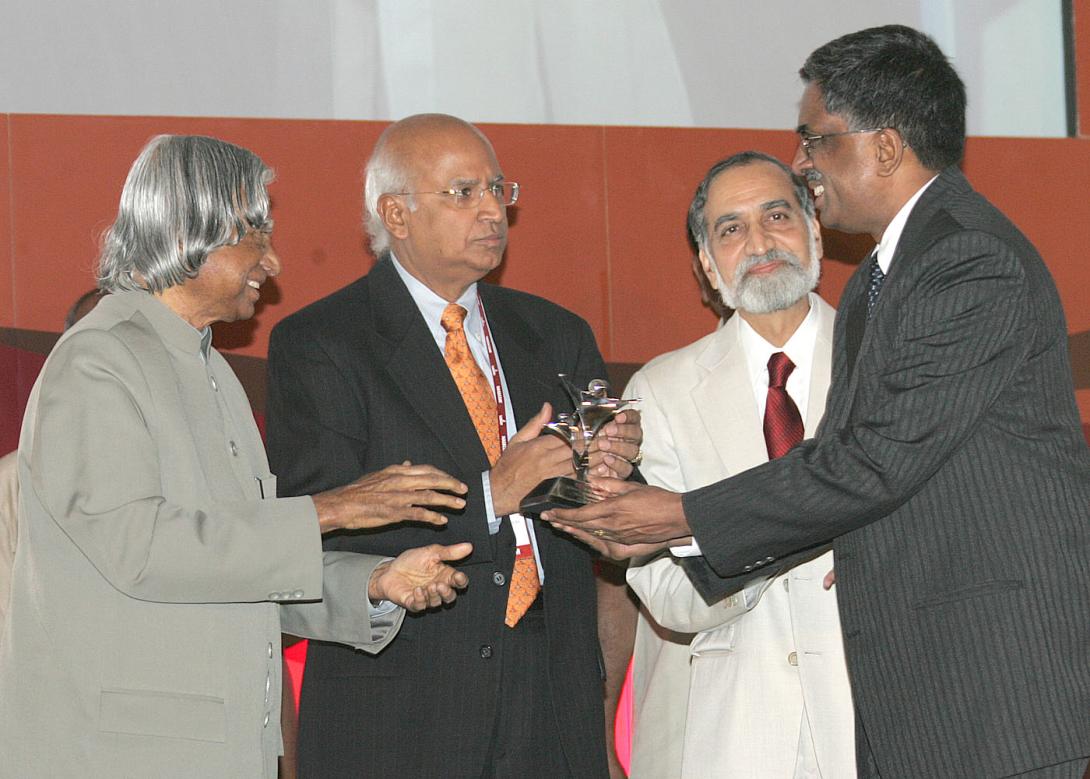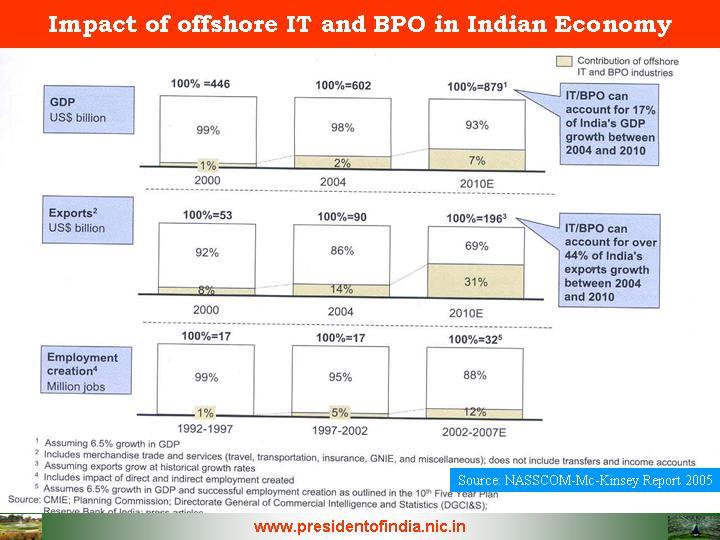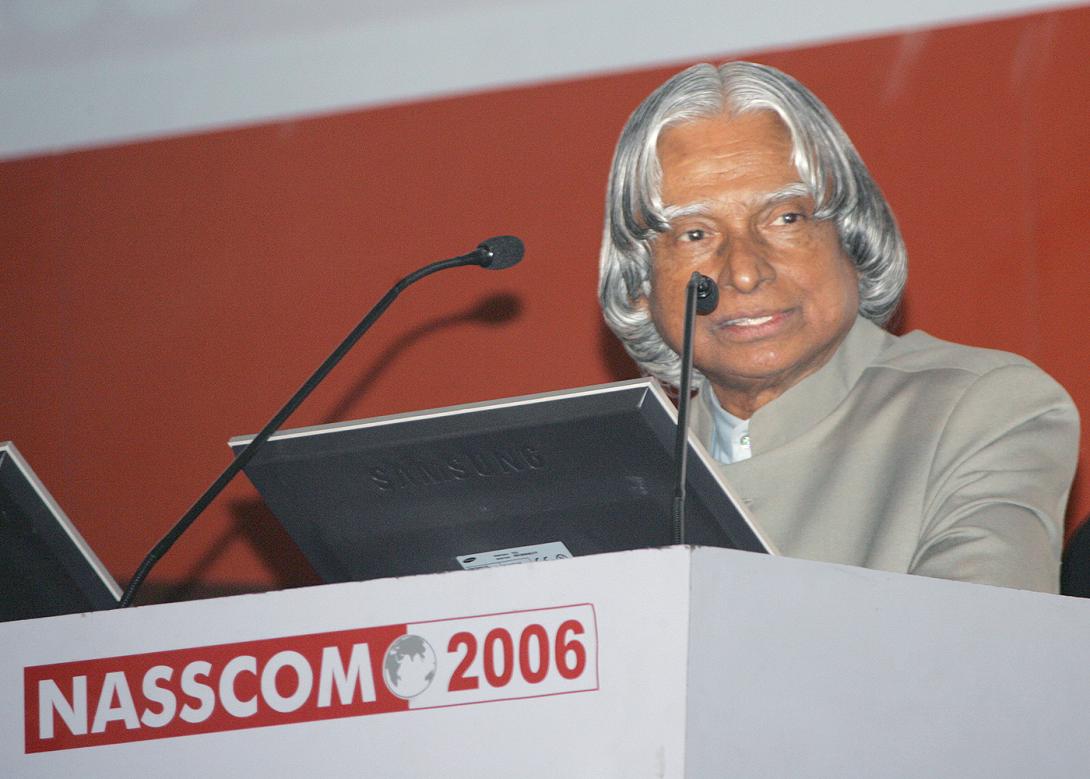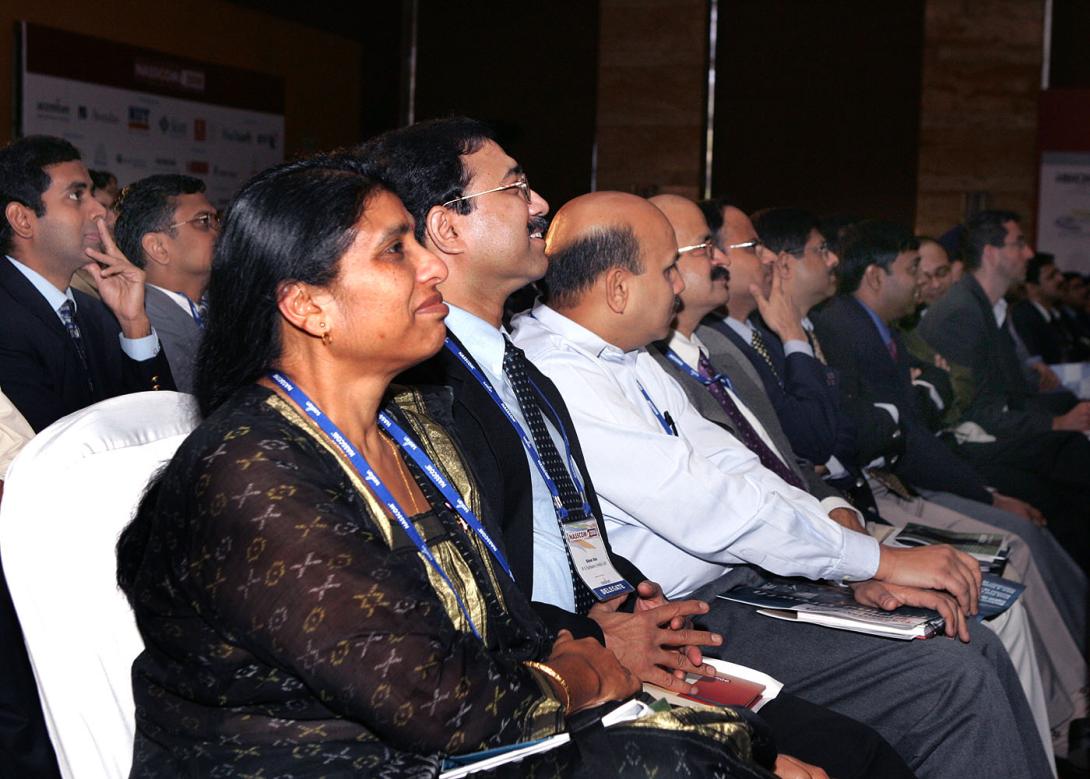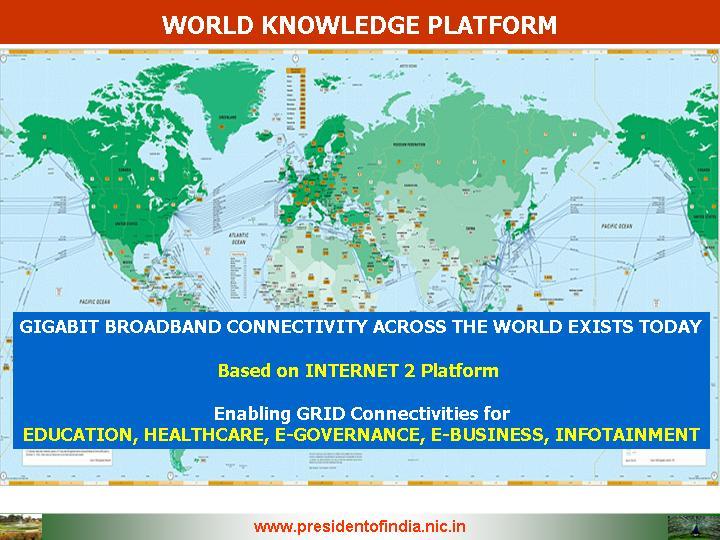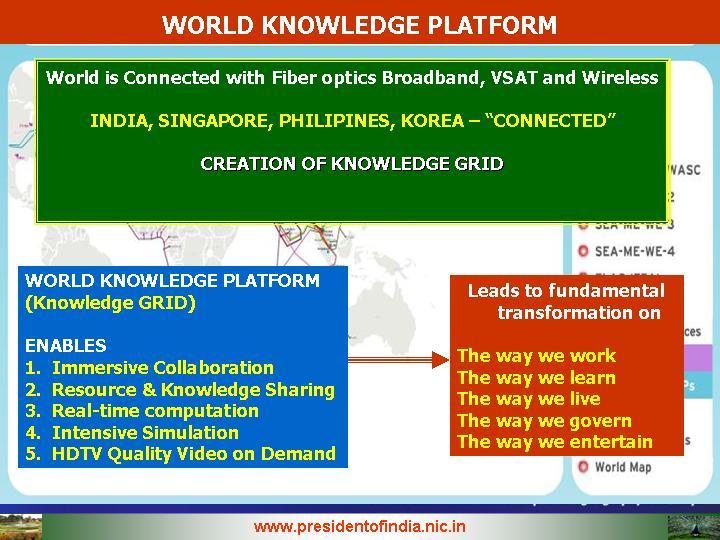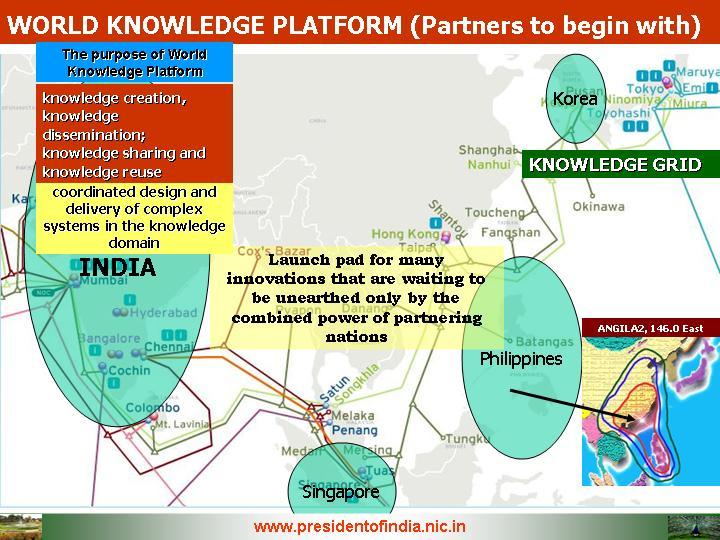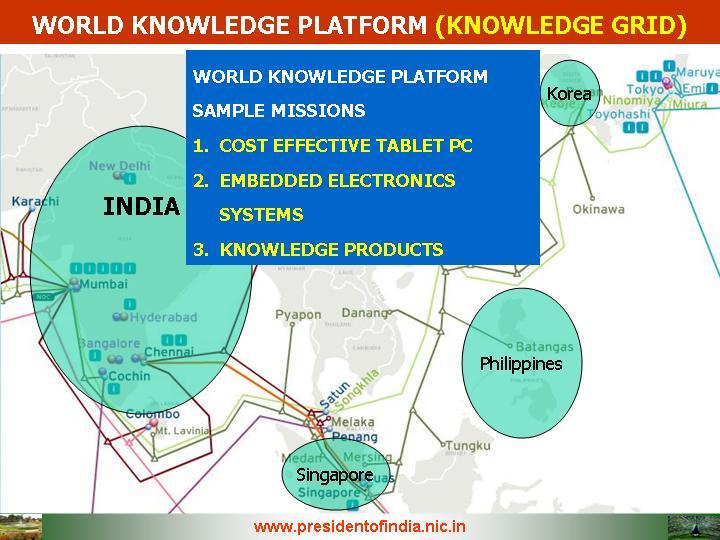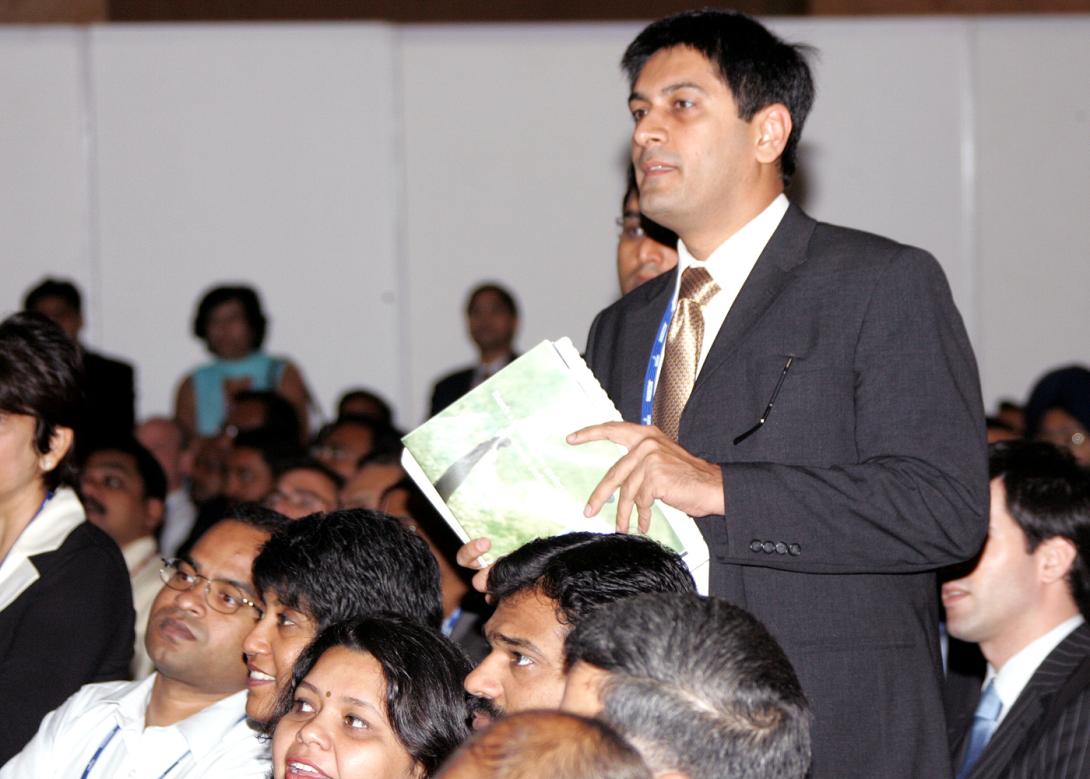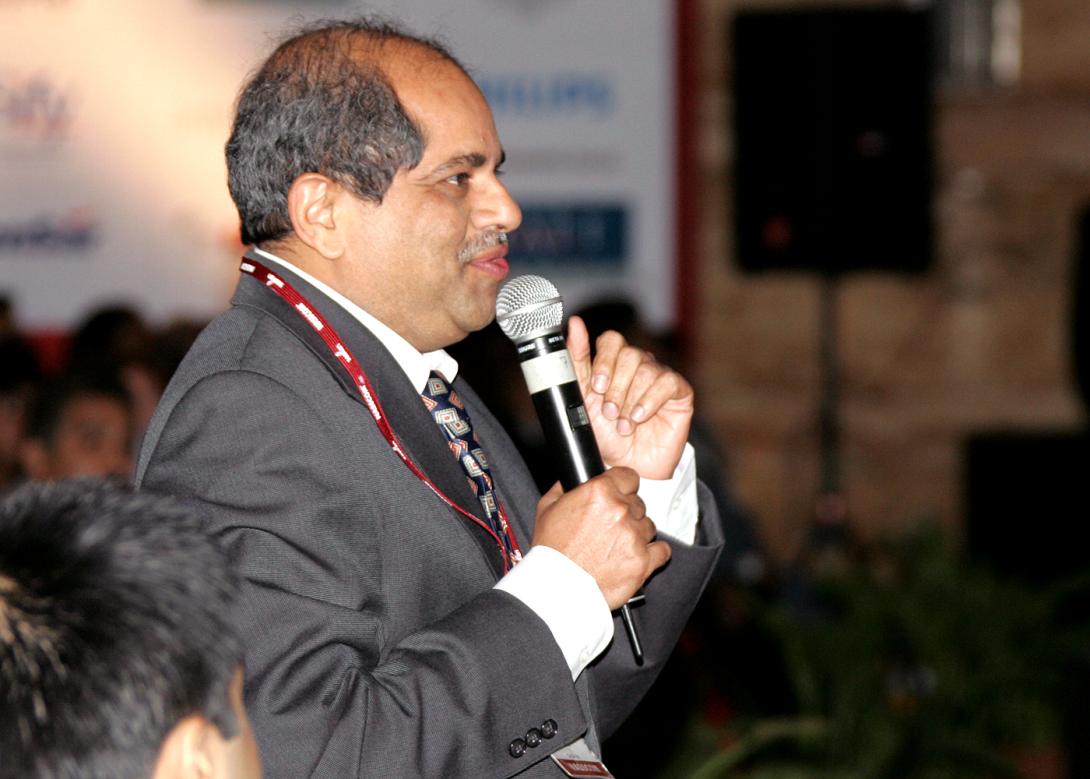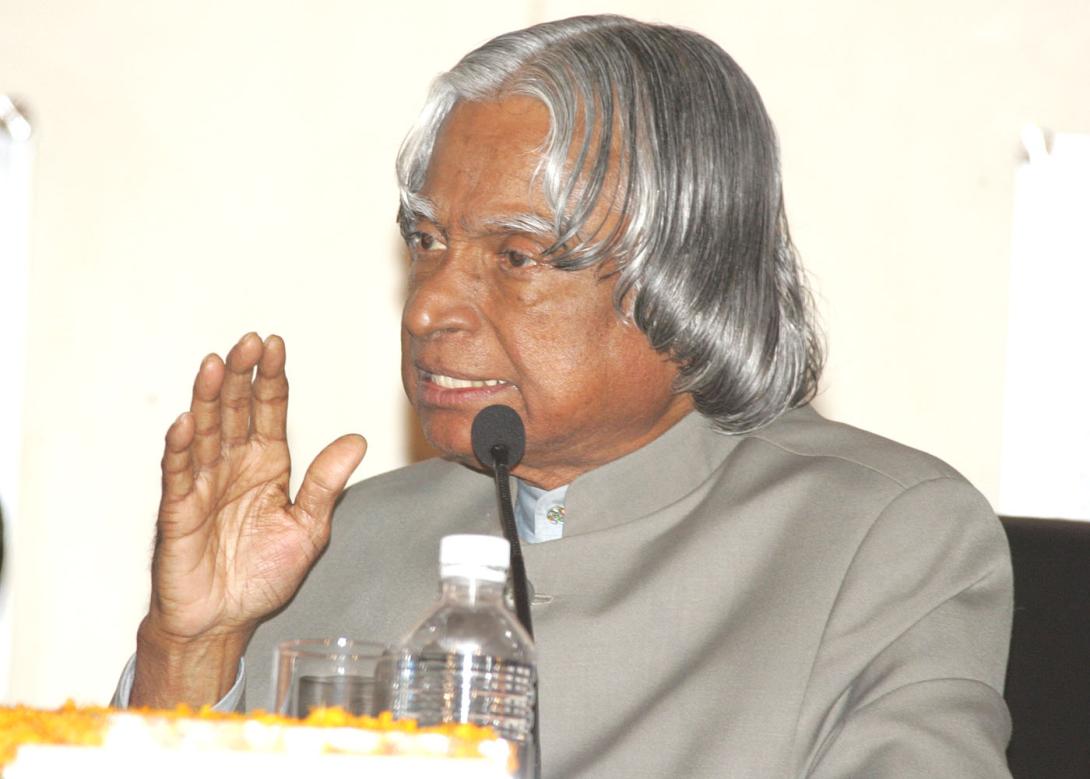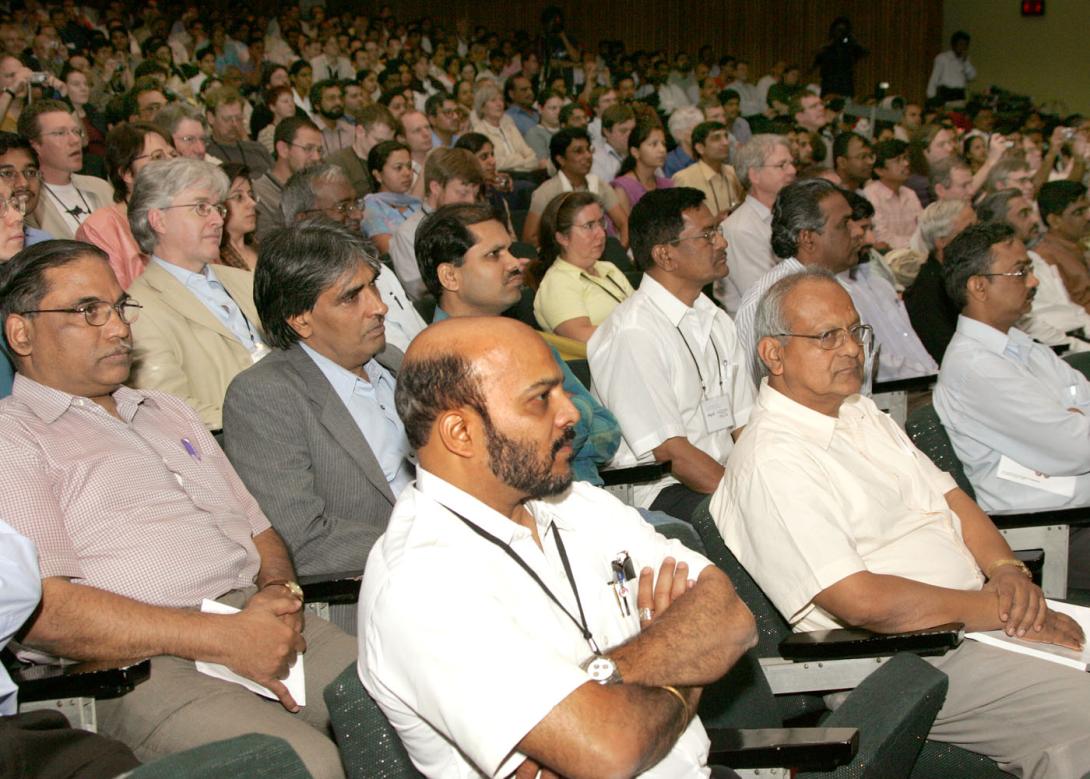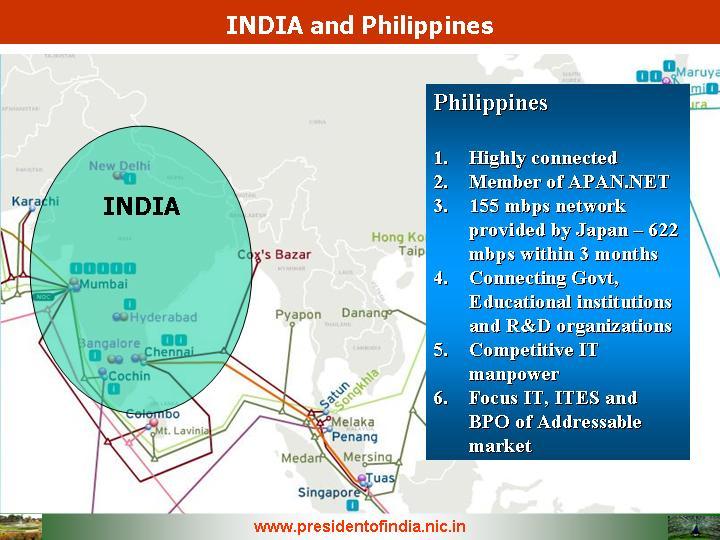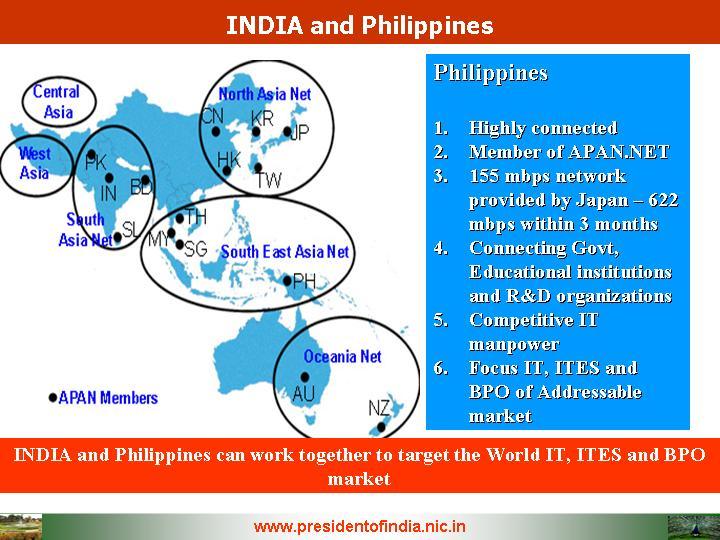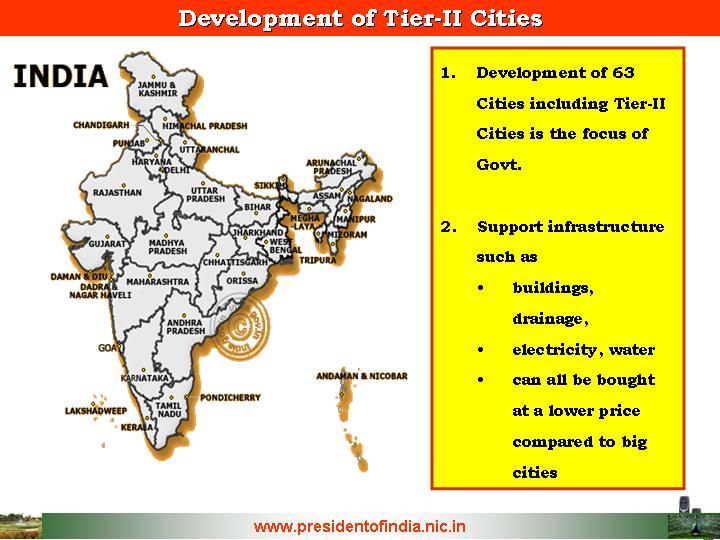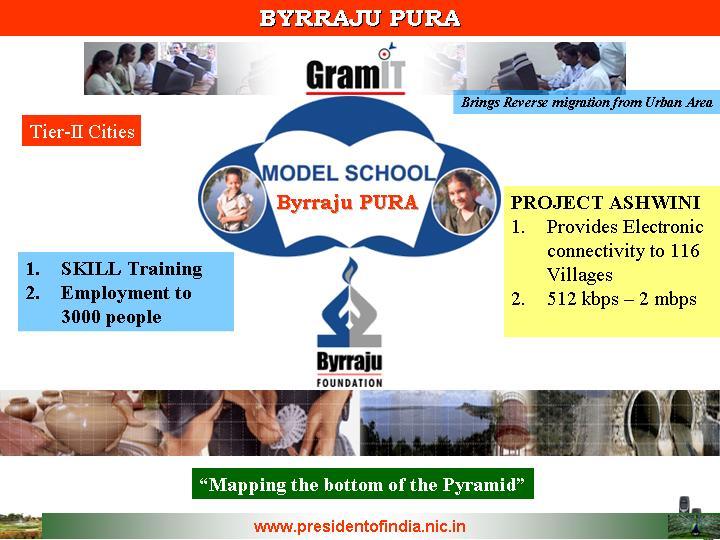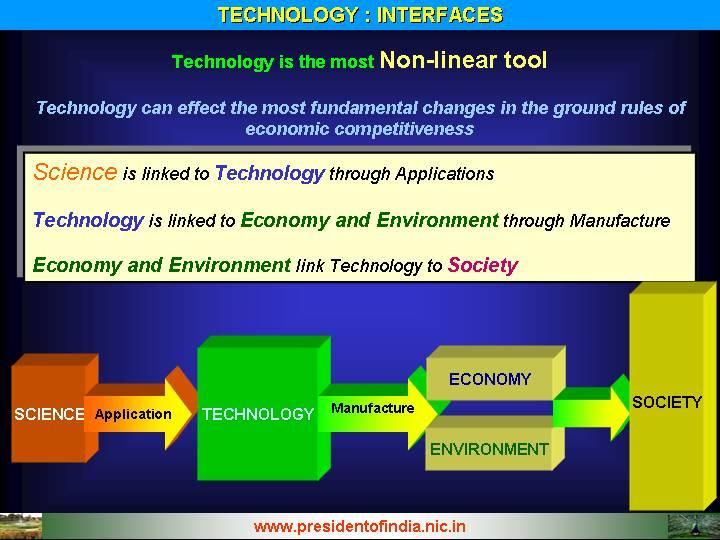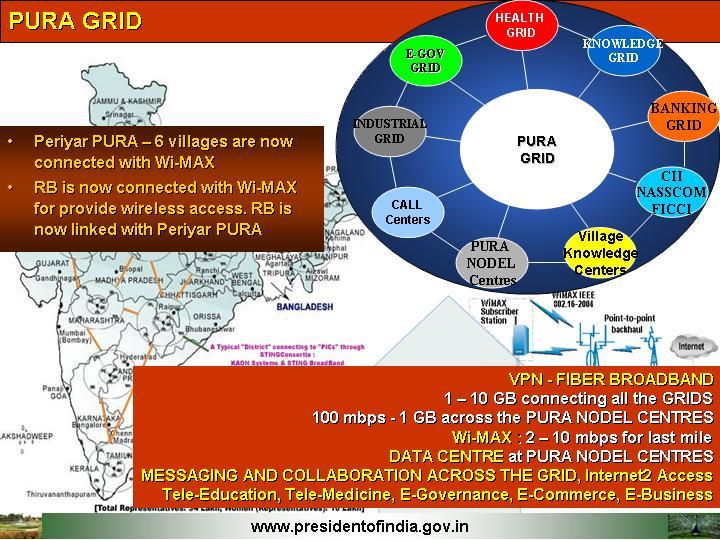Address At The Special Session Of Nasscom-2006 India Leadership Forum
Mumbai : 17-02-2006
World knowledge Platform
I am indeed delighted to participate in the special session of the NASSCOM-2006 India Leadership Forum. I greet all the leaders from the IT industries, major users of ICT, scientists, technologists, product developers, service providers, business teams, distinguished guests and also the silent professionals in the call centres. I congratulate the Indian IT Industry for their significant contribution in enhancing the turnover from $ 28.4 billion in 2005 to $ 36.3 billion in 2006 with an export component of $ 23.4 billion. This is definitely a notable achievement by the industry. I also find that from the present projection of NASSCOM the country is expected to reach a target of only US $60 billion by 2010. I have certain differences in your projection of business and also I would like indicate how to improve the business profile at least by three times.
IT services and ITES ' BPO sector accounts for 3.5% of the global market, which should be increased, to 15% of the global business volume. That means we should aspire to increase our market share to $200 billion in the IT services, ITES and BPO sector. From the analysis of the data from the year 2006, I find that we are far from reaching this target. We have to collectively see how we can realize this goal at least by 2010 if not by 2008.
Addressable Market
The NASSCOM - Mc. Kinsey Report 2005 indicates that the addressable market for global offshore including BPO is around $300 billion presently, whereas we are only tapping 10% of this addressable market. As estimated the contribution of offshore IT and BPO industries can account for 17% of India's GDP growth and 44% India?s export growth between 2004 and 2010. If we have to reach the goal of $200 billion by 2010 we have to work to refine the overall available
addressable market across the world and create awareness among the clients about the win-win situation of outsourcing the tasks with quality delivery. Globally, North America and Western Europe were the major market, together accounting for more than three-fourth of the global IT-ITES market. In this process if we can convert $400 billion of addressable market in 2010 into actual market, India should aim to do business at least 50% of the potential market.
How to attain the target: In order to attain the target the essential components needed for the ICT industry are as follows:
1. India's with its cost leadership in software products now it has to aim to the competitive in quality of the products and just in time delivery. Since there are number of countries competing for the $300 million market, continuously has to aimed high.
2. NASSCOM and Governments have to assist small enterprises in software to have a standing in the market. This can be through consortium approach for business.
3. A major drive has to be undertaken in capacity building of graduates with the aim to provide value added IT Services, ITES and BPO.
4. We need to encourage innovation and creativity among our IT personnel and thereby contributing towards attractive solution to the customer resulting in higher return on investment in their business process.
5. Focus our ICT market also towards Asia Pacific, ASEAN and African countries so that we are more competitive than any other nation due to the human resource potential and cost advantage capability with our core competence in ICT sector.
6. Turn your focus on India, which has one billion people as market force who need potential in education, healthcare, e-governance and e-business. Certainly, it is the responsibility of the Government, NASSCOM and the Indian industries to enable a level playing field for the growth of small and medium ICT industries to contribute for bringing down the digital divide.
7. India has a "Focus AFRICA" policy and there is a commitment to assist Africa development. In 2004 when I addressed the Pan African Parliament I announced India?s willingness to establish a Pan- African e-network for connecting 53 countries for providing tele-education, tele-medicine services and also connecting the Heads of State. Already the project is in progress, Indian ICT industry has a great potential to participate through this platform for creation of new market.
8. During my recent visit to Singapore, Philippines and Republic of Korea, I proposed the World Knowledge Platform. This will bring the core-competence of the partnering nations for design, development, production knowledge products and systems. World Knowledge Platforms also envisages evolution of new market through e-business network.
I consider that these collective and integrated action in all these areas will enable us to reach the targeted goal of $200 billion of business in the IT, ITES and BPO sector during the year 2010.
Now I would like to discuss about the "World Knowledge Platform", which will provide a greater opportunities for the R&D organizations, Institutions, ICT, BT and other manufacturing industries for joint design, development, production and marketing of knowledge products to meet the world market in association with the partnering nations.
World Knowledge Platform
In the proposed "World Knowledge Platform", India and the other like-minded nations will become the strategic partners in trade, business and industry.
In ASIA region, our countries have over the years established certain core competence in different areas. If we can pool these competencies, we will be delivering a synergetic performance for the world market. Hence it is necessary to an institutional mechanism called World Knowledge Platform. This platform will enable joint design, development, cost effective production and marketing of the knowledge products in various domains based on the core competence of partner nations.
Knowledge GRID: Initially, the mission of World Knowledge Platform is to connect and network the R&D Institutions, Universities and Industries using fiber broadband from the partner nations on selected R&D Missions. The underground fiber cable infrastructure already exists between the many partners. It is only waiting to be lighted up with state-of-the-art optical networks and to ignite the minds of the
knowledge workers. This knowledge GRID will support multitude of seamless connections supporting both synchronous and asynchronous communication, carrying either text, or audio or video. We can then use this network in the academic environments to teach courses online and share expensive equipments remotely. In the Industrial environment, it can be used to design complex systems ? even ones that are as complex as an aircraft in a collaborative way using virtual prototyping concepts in the cyber space.
Today, in any multinational company, it is common to see that many of the team members come from very different countries and cultures. For any one to be productive and
competitive in such an environment and work with purpose, it is important that we all should understand each other?s culture thoroughly and learn to respect them. I am also of the firm opinion that when culture is embedded into our Knowledge Platform, all our productivity would enhance considerably. I propose that we should allocate adequate bandwidth in the Knowledge network for us to share and cherish each other?s culture - be it used as heritage learning, be it history or be it entertainment.
Missions of World Knowledge Platform: The convergence of Bio, Nano and ICT is expected to touch every area of concern to the humanity. The ?World Knowledge platform? will take up the missions, in some of the areas given below, which are of utmost urgency to all of us to make our world a safe, sustainable and peaceful and prosperous world:
1. Energy exploration, storage, production and conversion
2. Water treatment
3. Disease diagnosis and screening
4. Drug innovation and delivery system
5. Food preservation, storage and distribution
6. Construction industries
7. Health Monitoring and extension services
8. Hardware, Software and Networking Products ? design, development and production
9. Automobile Hardware, embedded software integration
10. Gene Characterization, Stem Cell research and molecule to drug towards the diagnostic and treatment of the diseases like Cancer and Diabetics.
11. Herbal and natural products
12. Tourism and related services
In addition to the areas mentioned above, areas such as electronics, ICT and Automobile Sector may also be focused especially in the areas of design, development leading to productionization for meeting the market demands of the respective countries and also for world market. The core competence of India is software and the core competencies of the other partner nations are hardware and software, it can lead to design, development and marketing of world class systems that is equally dominated by the software intelligence and hardware innovation. The world knowledge platform will also evolve a virtual design centre with the participation of collaborating countries.
For example, initially the following specific missions are under consideration:
A. Tablet PC
Joint design, development and manufacture of a handheld tablet PC with multilingual capability in a cost effective manner with open source operating system and software configured for the school students and the common citizen who wishes to benefit from our E-Governance initiatives to meet the requirements of Asia pacific and African countries. This PC will have the wireless connectivity so that it can take care of the communication needs and possibly even the Telephone and will have sufficient video capability to act as an entertainment platform and for tele-education and telemedicine and even a hand writing recognizer that will also permit authentication for secure e-business transactions. The challenging task will be to configure, develop and produce and market the tablet PC at a cost of $100 to $150, so that student, teacher to researchers will be in a position to utilize it. Recently when I visited the Samsung Fab at Korea this thought we discussed with them.
B. Embedded electronics Systems
Design and development of embedded systems integrated with hardware, software, network in automobile sector, consumer electronics, aerospace systems, defence systems and precision manufacturing
C. Knowledge products for Societal Transformation
Design, development and customization of knowledge products in the field of Tele-education, Tele-medicine and e-Governance for Global business opportunities.
India and other like-minded countries initially form a consortium for the vertical missions of the World Knowledge Platform in the above-mentioned areas with the public, private partnership. In short, the Knowledge Platform would be launch pad for many innovations that are waiting to be unearthed only by the combined power of multiple nations. In essence, the World Knowledge Platform is indeed an integrated capability of multiple core competence of partner countries to generate knowledge products.
E-Business Network: This framework would bring robust economy in a faster scale, business transaction, knowledge exchange, joint business operations, quick exchange of information and round the clock business with lesser legal constraints. Initially, the proposed E-business network between India and partner country, would cater to two major segments namely B2B (Business to Business) and B2C (Business to Consumer). I hope our IT and BT industries should be ready to become the partner to this mission with a specific focus resulting knowledge products to bring economic prosperity to India and partnering nations.
ITES from India and Philippines
During my visit to Philippines I found that they are very keen to work with India in the IT services and ITES sector. Also I found that the electronic infrastructure is extremely well developed in Philippines. For example, Philippines have established APAN.NET in association with JAPAN in Manila that connects Government, Educational and R&D institutions and provides 155 mbps bandwidth connectivity around Manila and they are scheduled to upgrade it to 622 mbps within 3 months time. Manila has connected through Wireless.
Their institutions are holding virtual conferences and collaboration for all its conferences and seminars to improve the productivity and research because of the necessity of electronic connectivity within 7000 islands. Keeping these in view, NASSCOM can work with the industry captains assembled here and locate industries in partnership with Philippines Government where both Indian software professionals and Philippines software professionals can work together and bring out products and services for international market and also can cater to both the markets in e-governance, education and healthcare. Philippines Government is eager to meet the NASSCOM Team to concretize the cooperation areas in IT, ITES and BPO sector.
Development of Tier-2 cities for production of cost effective products
Government is focusing on the development of infrastructure in 63 cities which include large number of Tier-2 cities. This will enable development of infrastructure needed for these Tier-2 cities and also reduce the congestion in urban areas. I have discussed this during my address to the Karnataka State Assembly. It will also bring down the cost of operations, since the support infrastructure such as buildings, drainage, electricity, water can all be bought at a lower price compared to big cities. In this connection, let me discuss with you a success story from Bhimavaram a town in Andhra Pradesh.
Byrraju PURA
I visited a PURA complex created by Byrraju Foundation of Satyam which has undertaken the mission of establishing 32 Ashwini centers benefiting 116 villages with the population of around 500,000 people. It has provided the electronic connectivity through wireless (512 kbps to 2 mbps), knowledge
connectivity in cooperation with National Academy of Construction, Hyderabad and other domain experts, thereby creating economic connectivity in these villages.
Economic Connectivity: During the last 4 years of its operation, it has skill enabled and knowledge enabled in areas such as construction, tailoring, Garment production, IT and spoken English skills. This programme resulted in 3000 jobs with the minimum earning of Rs. 3000 per month, this is 3 times that of their earlier earning potential. A rural BPO Gram IT, established in Jallikakinada center has trained the unemployed graduates in IT skills and Spoken English and employed 100 people to do the BPO operations such as transaction processing of Human Resource data of Satyam Computers as a back office processing; data processing of one million self-help-group members of Andhra Pradesh such as financial data, accounting data, spending pattern, cultural aspects under the programme of �Mapping the bottom of the Pyramid�. This Gram IT BPO has effected the 10% reverse migration from Hyderabad to Bhimavaram. I am sure this Model can be replicated by many of our IT companies in the rural sector to create PURA clusters and bring rural transformation.
Technology Interfaces
Technology is the non-linear tool available to humanity, which can affect fundamental changes in the ground rules of economic competitiveness. Science is linked to technology through applications. Technology is linked to economy and environment through manufacture of knowledge products. Economy and environment are linked to technology, which promotes prosperity to the society. In the early mid 1990s the growth in the ICT was non-linear. Subsequently, I find that there is a stagnation and we are expecting the industry to grow at a sequential growth of around 25% to 27% and deliver nearly only US $ 60 billion as export business by 2010. This situation needs change and we have to aspire to increase our software export to $200 billion as stated above. It will need adoption of multiple innovative strategies by the NASSCOM and the industry partners as I have discussed above both from the view of supply side management and demand side management.
In addition to the support for the export market there are major activities, which have to be completed in the domestic area. We have a national e-governance plan with twenty five-mission mode project. Also, state-wide area network has to be established by 2007. Computerization of over nearly 13, 500 district and subordinate courts are required to be completed. The software industry has to provide solutions for all these tasks within the next two to three years. Other major areas of activities for the software personnel are establishment of village knowledge centres, education and healthcare facility for remote rural areas.
Electronic and knowledge connectivity for rural sector (PURA GRID)
The 600,000 villages of India need last mile connectivity through Wireless. Now the world is moving towards Wi-MAX technology for last mile access and low cost personal
computers and mobile devices. For example, in Periyar PURA, 6 villages are now connected using Wi-MAX terminals and are connected to Rashtrapati Bhavan. India needs to embark on a mission mode programme to establish the industries, which covers the total life cycle of hardware, and networking products in collaboration with international partners for design to manufacture and marketing worldwide. NASSCOM should take the initiative and work for diversification of the products for making it available for the creation of village knowledge centres in each one of the 2,25,000 Panchayats in the country. Such connectivity can also be linked to the tele-medicine connectivity needed for providing quality healthcare to our rural masses. Also our industry has to work for creating virtual classrooms through universal tele-education system for making quality education reach the interior areas of the nation. PURA GRID envisages these connectivities and ensures that it outreaches the people with education, healthcare and e-Governance services to empower them with skill, knowledge thereby creating economic development through e-business network. IT industry can make a singular contribution towards providing IT Enabled Services and the establishment of Rural BPOs to provide value added services to the people there by creating a sustainable economy in the rural sector.
Suggestions for NASSCOM-2006
Now, I have the following suggestions for the NASSCOM-2006 India Leadership Forum:
a. Creating awareness among the addressable market clients about the win-win situation arising out of out-sourcing IT, ITES and BPO to Indian companies, thereby, converting the addressable market into an actual market.
b. Promoting creation of BPO industry in the Tier-2 cities with a population of around one million to start with which can be extended further to city town with five lakh population.
c. Establish joint ventures between countries such as Philippines and Korea and other East Asian countries where the infrastructure is already there and the overall cost of operations is also low. This will enable servicing of large number of customers.
d. Participating in the development of e-governance, tele-education, tele-medicine and e-business across the country for making the benefits of ICT reach the common man in all his sphere of activity. Create a level playing field for the Small and Medium ICT industry to participate in this process. Encourage Consortium approach to provide total solution.
e. Participate in the provision of connectivity to the billion people through village knowledge centers, mobile telephones and provision of domain services on the lines of Kisan Call Centre for entrepreneurial skill development and employment generation, Travel and Tourism, Banking and Insurance, Meteorological forecasting, Disaster Warning systems, Education and Human Resource Development and Health care.
f. Become a partner to the World Knowledge Platform and E-business Network and there by attain the targeted growth of $200 Billion by 2010.
Conclusion
Dear Participants of NASSCOM-2006 India Leadership Forum, so far I have discussed about the strategies needed for enhancing the business volume from the planned US $ 60 billion to at least US $ 200 billion export market by 2010 and servicing the major IT initiatives being taken by the country in e-governance, tele-education and tele-medicine as a part of its growth plan. I have also discussed about the World Knowledge Platform and e-business initiative. This will need a new way of thinking and a new type of leadership to introduce technological non-linearity and also to enable the utilization of full potential of all our people. Think of new forms then only you can realize such goals. As I have mentioned earlier, this will need lot of courage to break out of the present mode of operations and attempt new leadership forms. I am aware that the tasks are difficult hence; I recall the great saying of the Saint Maharishi Pathanjali in Yoga Sutra at 500 BC:
"When you are inspired by some great purpose, some extraordinary project, all your thoughts break their bounds. Your mind transcends limitations, your consciousness expands in every direction, and you find yourself in a new, great and wonderful world. Dormant forces, faculties and talents come alive, and you discover yourself to be a greater person by far than you ever dreamt yourself to be."
My best wishes to all the participants of the NASSCOM-2006 India Leadership Forum for success in their mission of promoting non-linear growth and maintaining the vibrancy of the Indian ICT industry.
May God bless you.

